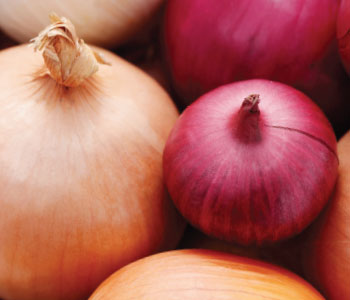Not your ordinary onion
This article was originally published in November 2014
Widely used but often an afterthought, the humble onion can transform a dish, adding depth and complex flavor. Additionally, how these bulb vegetables are stored, cut and cooked can greatly impact the outcome of your casseroles and gratins, soups and stews.

Selecting
From August to April, our yellow, red, white and sweet onions arrive from Brian and Denise Andersen of Andersen Organics in Othello, Wash. There they employ drip irrigation and other sustainable practices to produce onions that are “exceptional, full-bodied and flavorful,” says PCC produce merchandiser Joe Hardiman. When selecting onions, choose ones that are firm and heavy for their size and free of blemishes and soft spots. Yellow, red and white onions are considered pungent and best for cooking; sweet onions are milder and best used raw.
Storage
Keep onions in a dark, dry place where moisture can’t collect, such as bins or pantries. Don’t place them in plastic bags, and try to keep them separate from other veggies as they can pick up the flavor of other produce and vice versa.
Prep
If you want to avoid tears, freeze your onions for a few minutes before cutting them. Another option is to light a candle beforehand or to cut them near a lit gas burner. When it comes to flavor, the inner layers of an onion are more pungent while the outer pieces are milder. When cutting them, the smaller the dice, the more complex the flavor. Slicing onions against the grain also will produce a bolder flavor.
Quick tip
Salt onions while they’re cooking instead of seasoning them afterward. The salt draws out moisture and makes them soft and tender.
Red Onion Jam
Spread this jam on sandwiches or burgers, spoon it over roasted meat and poultry, or serve it as an accompaniment to cheese platters. Try our recipe for Red Onion Jam >>
